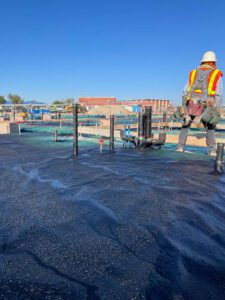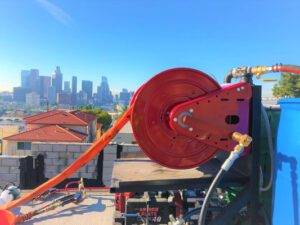Methane Gas Vapor Mitigation Construction is a specialty field with minimally certified contractors available relative to other construction trades.
This is an intentional result of the methane vapor barrier manufacturer’s selective certification process.
To implement quality control measures, methane membrane manufacturers only certify a select number of contactors within regions to install their product.
This is necessary due to the detail-oriented nature associated with the installation of methane mitigation systems. Historically, vapor barrier manufacturers find an open source installation approach leads to a wide variety of failure modes of Methane Vapor Mitigation Barriers.
Although limiting the number of certified installers is beneficial for material manufacturer’s quality control. It often puts general contractors, owners, and real estate investors in a vulnerable situation. In which they are overseeing the construction of a process that they do not understand. It is important for an owner and general contractor to understand the methane mitigation system, the local building requirements, and the scope of work that a methane mitigation contractor is offering within their bid.
 What should I review on a Methane Gas Control System Bid?
What should I review on a Methane Gas Control System Bid?
There are several questions General Contractor should ask when reviewing a methane construction bid. Verifying this information will ensure the bidding process of your Methane Mitigation Construction System conducting in efficiency and accuracy.
The proposed material that is being used should be noted on the construction bid and match the corresponding specifications on the Methane Mitigation System. Often, Gas Mitigation Contractors will make substitution for lower cost materials that are not equivalent. If this happens, you could end up with issues during the inspection of your Methane Mitigation system. Ultimately, the inspector can require you to implement the methane barrier that is specified on the plans, resulting in significant Change Orders.
Another important reviewing point is the scope that is being covered by the Vapor Mitigation Builder
Some aspects of methane mitigation construction overlap with concrete scope of work, this includes gravel or sand blanket and the Visqueen layer. There are also some aspects of methane mitigation construction that will overlap with your plumber and your electrician. Some Mitigation Contractors will include this work in their bid while others will have this scope excluded. It is important to review the proposed scope of all bids and ensure that you are fairly comparing the bids and accurately representing the Methane Mitigation Design specifications.
The mobilization schedule requires thorough reviews to characterize how the Gas Mitigation Contractor has plans to execute the construction. This is a very good representation of the how the contactor plans to execute the construction project. It also allows you to verify that all the scope of work is covered and comparable amongst the three bids that you received.
Every job is different and requires a different mobilization schedule depending on the scope
Also depending on how the construction will be organized. Ensuring that this is done accurately is important and requires a significant amount of detail. Unfortunately, methane mitigation contractors often do not want to put the time and effort into the sequence of events during construction, but this is a key component to preparing an accurate Mobilization Schedule. Some Vapor Barrier Products are designed as a fluid sprayed applied membrane that requires a pump for installation. With these products, the mobilization fees can be high, leading to large Change Orders in the event that unaccounted for Mobilizations are required.
 How many Mitigation Construction Bids should I get for a project?
How many Mitigation Construction Bids should I get for a project?
It’s best to get three Vapor Mitigation construction bids, this allows for a better understanding of what the cost is for a system on a low, high, and medium spectrum. By receiving three construction bids you’re able to weed out bids that might be too low or too high. If a General Contractor were to only receive one construction bid, the possibility of inaccurate bidding is much higher, which can lead to budgeting issues during construction.
How do I know if my Methane Gas Control Contractor is good?
According to the Contactor State License Board (CSLB), the best way to find a contractor is through referral. The Construction Industry’s Bidding process has changed significantly with the use of internet search browsers like Google. General Contractors and Owners have the ability to receive “Cold Bids” from a variety of companies without actually knowing how the contractor performs the work and how the business is managed. Although having the ability to receive bids from multiple companies easily is a huge benefit. Receiving these cold bids could be a counterproductive action due to the uncertainty and unreliability of these leads. In the construction industry, word of mouth from your sphere of influence is still the best way to find a reliable Methane Vapor Mitigation Contractor.
Methane Construction Bids
When receiving a construction bid from a specialized Methane Mitigation contractor, it’s important to realize that this contractor may also take on any necessary Waterproofing Project. This helps reduce costs, and in some cases, increase efficiency by increasing productivity, Also by minimizing the required communication between different trades. This is because most Methane mitigation materials are also certified as Waterproofing materials. Although this is true, not all Methane Mitigation contractors take on the responsibility of waterproofing. It is always essential to ask your contractor what their scope capabilities are.
When receiving bids, another essential question is what the warranty periods for the Methane Mitigation system are. There are two types of warranties to acknowledge. One being the material warranty that the material manufacturer typically provides and the other being the labor warranty. To take advantage of these warranties, specific guidelines and processes must meet. These processes and guidelines by both by the Department of Building and Safety and the material manufacturer.
The sensitivity of Methane Mitigation Construction can easily lead to incorrect installations and failure of systems. It isn’t good if the proper inspections implementation don’t occur. Then it is possible for the material manufacturer and the contractor to not provide the associated home warranty. This is not a good situation to have involvement in. Thus it’s important to always budget the required inspections and processes related to Methane Mitigation. Informing your team members of these processes is also necessary. So that they will be fully aware that if these are not abided by, warranties will not be provided.
Considering the youth of the Methane Mitigation History, contractors are often not familiar with the entire process
As the owner is being offered a bid, it’s important to acknowledge your contractor being willing to learn and work with Methane Mitigation contractors. And be able to work with completing the systems. This will most likely be a learning process that the contractor must be open to and willing to take on. Some contractors may charge an associate of the price. This is common with dealing with the scheduling and logistics of Methane Mitigation systems. Since they are not typically involving in a standard project. So, be sure before construction begins that all parties are aware of the Methane Mitigation Construction Requirements. As well as aware of all associated work along with this.
It is an unfortunate occurrence that Methane mitigation requirements miss the mark on projects. Even if the building code requires them to be met. Often, this will come up at the final report of the inspection. If this occurs, it means that your architect, plan checker, and contractor are all unaware of the Methane Mitigation requirements for your area. This is an unfortunate occurrence that can be easily preventable.
This is by implementing the methane Mitigation check. Which can execute using ZIMAS on all projects that in construction within the Los Angeles area. If you are in the Los Angeles County Environmental Programs Division, the code requirements will be slightly different. You can check the website of the LA County Environmental Programs Division for information. If you are within Orange County, then you can check with their fire authority jurisdiction. Also check with their building department for your property’s Methane Mitigation Requirements.
